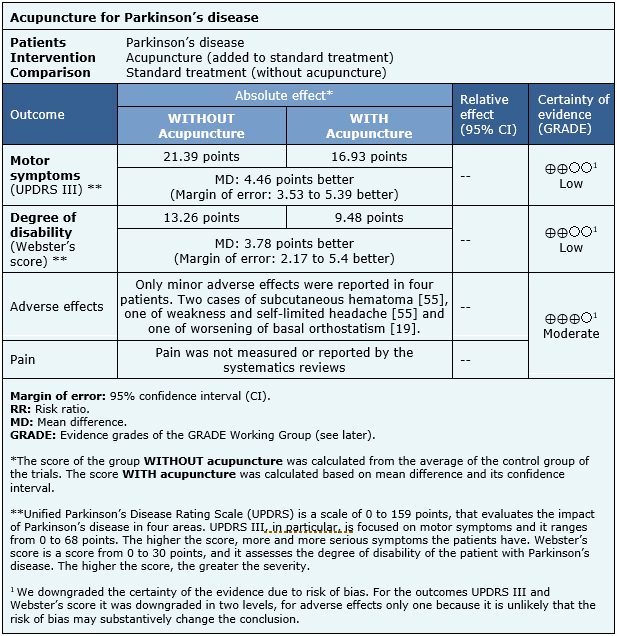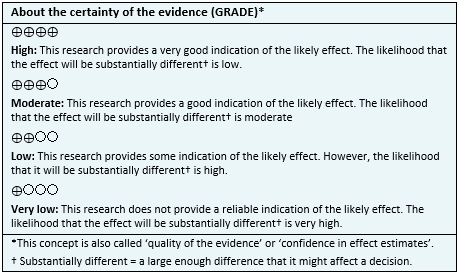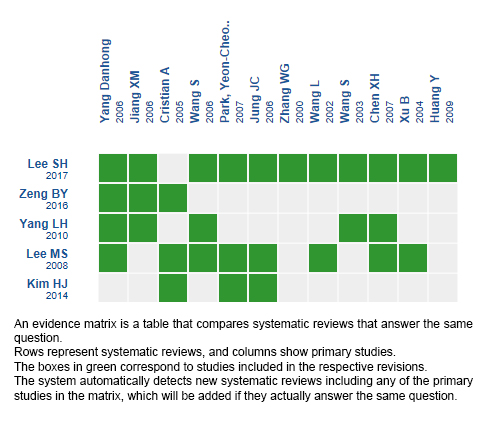Resúmenes Epistemonikos
← vista completaPublicado el 3 de mayo de 2018 | http://doi.org/10.5867/medwave.2018.03.7197
¿Tiene la acupuntura un rol en el tratamiento de la enfermedad de Parkinson?
Is acupuncture an alternative for the treatment of Parkinson’s Disease?
Abstract
INTRODUCTION It has been proposed that acupuncture has several benefits for patients with Parkinson’s disease. However, its real clinical effect is still under discussion.
METHODS To answer this question we used Epistemonikos, the largest database of systematic reviews in health, which is maintained by screening multiple information sources, including MEDLINE, EMBASE, Cochrane, among others. We extracted data from the systematic reviews, reanalyzed data of primary studies, conducted a meta-analysis and generated a summary of findings table using the GRADE approach.
RESULTS AND CONCLUSIONS We identified nine systematic reviews including 53 studies overall, of which 45 were randomized trials. We concluded acupuncture might have a small effect in improving motor symptoms and disability in Parkinson’s disease, but the certainty of the evidence is low.
Problem
Parkinson’s disease is a common chronic neurodegenerative disease. The treatment of choice is levodopa, but at long term its efficacy decreases and adverse effects like dyskinesia appear. At this stage, many patients look for complementary therapies, like acupuncture, which would exert systemic effects through local stimulation. Doing so, it would improve motor symptoms and disability. However, its real clinical effect in this condition is not clear.
Methods
To answer the question, we used Epistemonikos, the largest database of systematic reviews in health, which is maintained by screening multiple information sources, including MEDLINE, EMBASE, Cochrane, among others, to identify systematic reviews and their included primary studies. We extracted data from the identified reviews and reanalyzed data from primary studies included in those reviews. With this information, we generated a structured summary denominated FRISBEE (Friendly Summary of Body of Evidence using Epistemonikos) using a pre-established format, which includes key messages, a summary of the body of evidence (presented as an evidence matrix in Epistemonikos), meta-analysis of the total of studies when it is possible, a summary of findings table following the GRADE approach and a table of other considerations for decision-making.
|
Key messages
|
About the body of evidence for this question
|
What is the evidence. |
We found nine systematic reviews [1],[2],[3],[4],[5],[6],[7],[8],[9], that included 53 primary studies [10],[11],[12],[13],[14],[15],[16], |
|
What types of patients were included* |
Patients with Parkinson’s disease were included, with or without motor complications. However, the information about the degree of progression of the disease, the proportion of patients with cognitive compromise or other non-motor symptoms were not specified. |
|
What types of interventions were included* |
Sixteen trials used traditional acupuncture [18],[19],[21],[23],[27], In 33 trials it was compared against non use of acupuncture [19], |
|
What types of outcomes |
From the multiple outcomes measured by the trials, the systematic reviews grouped them as follows:
The follow-up ranged between four weeks and three months |
* The information about primary studies is extracted from the systematic reviews identified, unless otherwise specified.
From the multiple outcomes measured by the trials, the systematic reviews grouped them as follows: ● Motor symptoms through UPDRS (Unified Parkinson’s Disease Rating Scale) ● Degree of disability, measured through Webster score ● Adverse effects ● Constipation ● Vesical dysfunction The follow-up ranged between four weeks and three monthsSummary of Findings
The information about the effects of acupuncture in Parkinson’s disease is based on six randomized trials [21],[29],[31],[34],[41],[59] that included 396 patients overall. The rest of the trials did not report the outcomes of interest or did it in a way it was not possible to incorporate them in a meta-analysis.
All of the trials reported motor symptoms measured in the UPDRS III scale (396 patients), four trials [28],[34],[61],[62] reported the degree of disability measured with the Webster score (208 patients) and four trials [23],[24],[44],[55] reported adverse effects (150 patients).
The summary of findings is the following:
- Acupuncture might have a small effect in improving motor symptoms in Parkinson’s disease, but the certainty of the evidence is low.
- Acupuncture might have a small effect in improving disability in Parkinson’s disease, but the certainty of the evidence is low.
- Acupuncture is probably associated with mild adverse effects. The certainty of the evidence is moderate.


Other considerations for decision-making
|
To whom this evidence does and does not apply |
|
| About the outcomes included in this summary |
|
| Balance between benefits and risks, and certainty of the evidence |
|
| Resource considerations |
|
| What would patients and their doctors think about this intervention |
|
|
Differences between this summary and other sources |
|
| Could this evidence change in the future? |
|
How we conducted this summary
Using automated and collaborative means, we compiled all the relevant evidence for the question of interest and we present it as a matrix of evidence.

Follow the link to access the interactive version: Acupuncture for Parkinson's disease
Notes
The upper portion of the matrix of evidence will display a warning of “new evidence” if new systematic reviews are published after the publication of this summary. Even though the project considers the periodical update of these summaries, users are invited to comment in Medwave or to contact the authors through email if they find new evidence and the summary should be updated earlier.
After creating an account in Epistemonikos, users will be able to save the matrixes and to receive automated notifications any time new evidence potentially relevant for the question appears.
This article is part of the Epistemonikos Evidence Synthesis project. It is elaborated with a pre-established methodology, following rigorous methodological standards and internal peer review process. Each of these articles corresponds to a summary, denominated FRISBEE (Friendly Summary of Body of Evidence using Epistemonikos), whose main objective is to synthesize the body of evidence for a specific question, with a friendly format to clinical professionals. Its main resources are based on the evidence matrix of Epistemonikos and analysis of results using GRADE methodology. Further details of the methods for developing this FRISBEE are described here (http://dx.doi.org/10.5867/medwave.2014.06.5997)
Epistemonikos foundation is a non-for-profit organization aiming to bring information closer to health decision-makers with technology. Its main development is Epistemonikos database (www.epistemonikos.org).
Potential conflicts of interest
The authors do not have relevant interests to declare.

